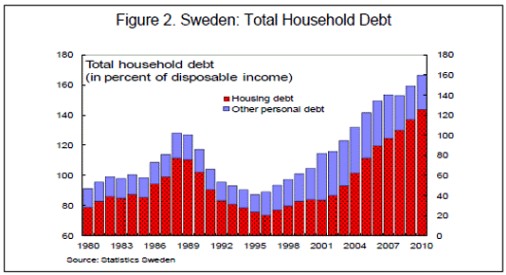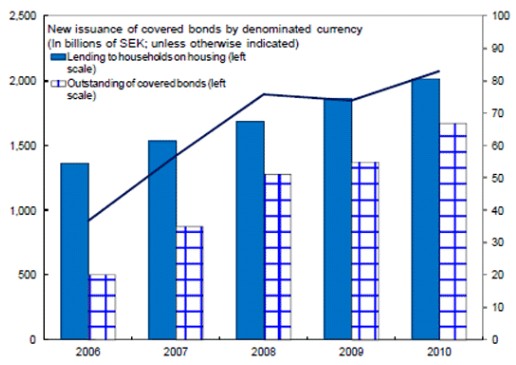
Cross-posted from Gareth Vaughan at Interest.co.nz comes the below discussion on Sweden’s loan-to-value (LVR) restrictions on mortgage lending, which were implemented in October 2010, and are expected to be tightened further along with bank capital adequacy requirements. While the article looks at Sweden from a New Zealand perspective, Australia and New Zealand share essentially the same banking system and a similar concentration of bank lending in mortgages. Therefore, the discussion is also highly relevant to Australia.
You’re the regulator in a country where the percentage of your banks’ loans to households has doubled in the space of 15 years and where the ratio of household debt to personal disposable income has reached a record high of 163%. So what do you do?
Simple. You do what New Zealand’s Reserve Bank seems reluctant to do and you introduce loan-to-valuation ratio (LVR) caps on home loans.
That’s what Sweden did in 2010.
“The main purpose was to address consumer risks arising from vulnerability of highly leveraged households to adverse development in the housing market. Finansinspektionen (the Swedish Financial Supervisory Authority) wanted to stem an unsound trend in the credit market where credit institutions would use ever-increasing loan-to-value ratios to compete,” a Finansinspektionen spokesperson told interest.co.nz.
“There is a risk that such a development will expose consumers to unacceptable risks and eventually damage the confidence in the credit market as a whole.”
Sweden, like New Zealand, was one of few developed countries whose house prices didn’t fall significantly during the 2008-09 global financial crisis. By 2010, 35% of total outstanding bank loans in Sweden were to the household sector, up from just 18% in 1995. And from the mid-1990s the ratio of household debt to personal disposable income steadily climbed, reaching a record 163% in 2010. And mortgage debt as a share of household income rose from 73% in 1996 to 145% in 2010.

Here in New Zealand 56%, or NZ$178.6 billion, of bank lending is in residential mortgages according to Reserve Bank sector credit data. And as of September 30 last year, our household debt to disposable income ratio was at 142.8%, down a bit from its 2009 high of 153.4%.
But back to Sweden. As the International Monetary Fund (IMF) puts it, after experiencing a severe economic and financial crisis from 1991–93, Sweden rebuilt its economy by implementing drastic reforms. In moves reminiscent of New Zealand in the 1980s, the fixed exchange rate regime was abandoned for a free floating currency, and a rules-based fiscal framework and inflation targeting regime were introduced. The introduction of inflation targeting in 1993 led to a decline in interest rates that improved debt affordability.
LVR caps were introduced on October 1, 2010. On new loans, or where existing loans are increased with residential property used as collateral, the cap is set at 85% of the value of the collateral.
“The LVR regulation has been successful in reducing the vulnerabilities of households,” the Finansinspektionen spokesperson says. “The banks have become more restrictive to issuing new loans with high LVR ratios. We have also seen a reduction in the average LVR ratio for new loans, as well as the decrease in the pace of credit growth.”
Sweden is a country where the average LVR ratio rose to 55% at the end of 2010 from 10% in 1995. And before the 85% LVR cap was imposed, the average LVR ratio on new-lending had risen to 75%.
The role of covered bonds
Another aspect of interest in the Swedish situation for New Zealand is the introduction there of covered bonds in 2004, something the Reserve Bank here has allowed New Zealand banks to issue since 2010. In Sweden from 2004, the IMF says, there has been a significant pick-up in mortgage lending.
“Under the Covered Bond Act, investors are secured by double recourse (as are holders of covered bonds issued by New Zealand banks) – meaning that they have recourse to both the collateral pool backing the specific covered bond programme and to the estate of the bank on its default. Since then, the outstanding (Swedish) stock of covered bonds has risen from 40% of GDP to over 160% of GDP,” the IMF says.
“The amount of covered bond issuance as share of total mortgage lending has doubled to 80% since 2006. Also, funding costs of covered bonds are cheaper than alternative means, including senior debt issuance, which has contributed to lower mortgage interest rates, in turn stimulating mortgage demand.”
New Zealand’s big four banks, led by BNZ, have borrowed more than NZ$11 billion through covered bonds since 2010 and Kiwibank is now poised to join them. The Reserve Bank says banks may each use up to 10% of their total assets as collateral for covered bonds.

LVR caps the only ‘new’ tool the Reserve Bank is considering
LVR caps on home loans are but one of four macro-prudential tools the Reserve Bank is currently consulting on. But of the others, the core funding ratio has been in use since 2010, the Reserve Bank says it’ll be prepared to introduce a countercyclical capital buffer from next year as part of the global Basel III bank capital adequacy reforms, and the fourth, increasing bank capital in response to sector-specific risks, was implemented on lending to the farming sector in 2011.
So giving itself scope to implement LVR caps on residential mortgages is really the only new tool the Reserve Bank is considering adding to its toolbox.
But in its consultation paper the central bank lists a range of concerns about, and potentially side effects from, implementing LVR caps. These include favouring wealthy home buyers/investors over first home buyers, arbitrage through unsecured, non-mortgage top-up loans, and a risk of “leakage” to the unregulated sector and foreign banks should there be an increase in new lending by the non-banking sector.
And bank lobby group the New Zealand Bankers’ Association pointed out another concern, with its CEO Kirk Hope raising the issue of mortgage lenders insurance.
“LVR comes down to the relationship between restrictions and what is underlying that by way of an insurance market,” says Hope.
He notes that in Canada and Hong Kong, where LVR caps are in place, the government plays a major role in lenders mortgage insurance meaning high LVR risk is transferred onto the government’s balance sheet, something our government is highly unlikely to want.
Whilst government sponsored insurance is available in Sweden, according to Finansinspektionen, its use isn’t widespread.
LVR caps are, or have also been, used in the likes of South Korea, Singapore, Thailand, Israel and Norway. Even if the Reserve Bank, Finance Minister Bill English and Treasury give the Reserve Bank the power to use them here, the central bank may choose not to do so. And even if they were used here, it’s likely it’d be a rare occurrence and for limited periods of time.
Major issues to mull, including possible crack-down on overseas investors buying existing NZ houses
Certainly high LVR home loans have returned with a vengeance over the past couple of years. Analysis by interest.co.nz shows the country’s big five banks, combined, grew residential mortgages where the borrower has less than 20% equity by NZ$3.3 billion, or 10%, during 2012. Home loans with LVRs above 80% are now up NZ$4 billion, or 12.5%, to NZ$36 billion since the Reserve Bank first mandated the banks break down their home loan books by LVRs in 2008.
As of December 31, borrowers had less than 20% equity on 24% of ANZ’s residential mortgage book, or NZ$12.9 billion worth of loans. ASB was at 21%, or NZ$8.2 billion, Westpac at NZ$8.5 billion, or 24%, BNZ at NZ$4.1 billion, or 14%, and Kiwibank at NZ$2.3 billion, or 19%.
Nonetheless, there are some serious issues, on top of the concerns aired by the Reserve Bank in its consultation documents, to consider.
For example, if used right now, would LVR caps even be needed outside Auckland and perhaps Christchurch?
And ought there be an exemption for first home buyers, perhaps the biggest users of high LVRs, and a group no political party will want to be seen to be “locking out” of the housing market? Remember that, based on January’s median Auckland house price of NZ$509,350, first home buyers would need NZ$101,850 to have a 20% deposit.
And if a first home buyers exemption was introduced, how could the Reserve Bank make sure it wasn’t rorted?
And what about adding something the Reserve Bank’s not currently considering but has been used elsewhere as part of macro-prudential frameworks, – restrictions on debt service-to-income ratios?
And if a massive house building programme suddenly kicked off in and around Auckland tomorrow, and/or our government decided to implement Australian style restrictions on overseas investors buying existing New Zealand houses, something the Green Party advocates, would the concept of LVR caps on home loans become irrelevant?

